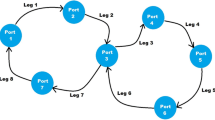Abstract
The changing prices of bunker fuel open the door for substantial cost savings by adjusting the sailing speed of ships. A large ship may be burning up to 100 000 USD of bunker fuel per day, which may constitute more than 75% of its operating costs. Reducing the cruising speed by 20% reduces daily bunker consumption by 50%. However, in order to maintain liner service frequency and capacity, reducing the cruising speed may require additional ships to operate a route. We construct a cost model that we use to analyse the trade-off between speed reduction and adding vessels to a container line route, and devise a simple procedure to identify the sailing speed and number of vessels that minimize the annual operating cost of the route. Using published data, we demonstrate the potential for large-cost savings when one operates close to the minimal-cost speed. The presented methodology and procedure are applicable for any bunker fuel price.

Similar content being viewed by others
References
Alvarez JF (2009). Joint routing and deployment of a fleet of container vessels . Maritime Econ Logist 11: 186–208.
Brown GG, Kline JE, Rosenthal RE and Washburn AR (2007). Steaming on convex hulls . Interfaces 37(4): 342–352.
Christiansen M, Fagerholt K, Nygreen B and Ronen D (2007). Maritime transportation. In: Barnhart C and Laporte G (eds). Handbooks in Operations Research and Management Science: Transportation. North-Holland: Amsterdam, pp 189–284.
Leach PT (2008). Galloping gulf line. The Journal of Commerce 7 July, p 22.
Notteboom TE (2006). The time factor in liner shipping services . Maritime Econ Logist 8: 19–39.
Notteboom T and Rodrigue J-P (2008). Containerisation, box logistics and global supply chains: The integration of ports and liner shipping networks . Maritime Econ Logist 10: 152–174.
Notteboom TE and Vernimmen B (2009). The effect of high fuel costs on liner service configuration in container shipping . J Transport Geogr 17: 325–337.
Ronen D (1982). The effect of oil price on the optimal speed of ships . J Opl Res Soc 33: 1035–1040.
Stanley B (2007). Ships draw fire for rising role in air pollution. The Wall Street Journal 27 November, p. 1.
Ting S-C and Tzeng G-H (2003). Ship scheduling and cost analysis for route planning in liner shipping . Maritime Econ Logist 5: 378–392.
Vernimmen B, Dullaert W and Engelen S (2007). Schedule unreliability in liner shipping: Origins and consequences for the hinterland supply chain . Maritime Econ Logist 9: 193–213.
Author information
Authors and Affiliations
Corresponding author
Rights and permissions
About this article
Cite this article
Ronen, D. The effect of oil price on containership speed and fleet size. J Oper Res Soc 62, 211–216 (2011). https://doi.org/10.1057/jors.2009.169
Received:
Accepted:
Published:
Issue Date:
DOI: https://doi.org/10.1057/jors.2009.169




